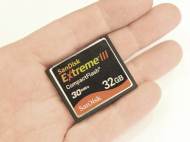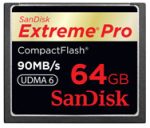SanDisk Extreme Pro CompactFlash cards set new speeds
 SanDisk has recently released new Extreme Pro CompactFlash memory cards claiming to elevate the professional grade performance, capability and reliability. These new memory cards are expected to establish a new standard for professional photography experience. It allows photographers to capture RAW format images and high-definition video clips in a single session without running out of space. Sandisk Extreme Pro CompactFlash cards come integrated with SanDisk Power Core Controller, a highly-progressive memory controller allowing lightning-fast read and write speeds of up to 90MB/s. It assists in enhancing the performance from earlier SanDisk high-end camera memory cards and offers storage capacities from 16GB to 64GB.
SanDisk has recently released new Extreme Pro CompactFlash memory cards claiming to elevate the professional grade performance, capability and reliability. These new memory cards are expected to establish a new standard for professional photography experience. It allows photographers to capture RAW format images and high-definition video clips in a single session without running out of space. Sandisk Extreme Pro CompactFlash cards come integrated with SanDisk Power Core Controller, a highly-progressive memory controller allowing lightning-fast read and write speeds of up to 90MB/s. It assists in enhancing the performance from earlier SanDisk high-end camera memory cards and offers storage capacities from 16GB to 64GB.
“The new SanDisk Extreme Pro CompactFlash line is the direct result of SanDisk’s passion, commitment, and break-through engineering innovation to provide best-in-class flash memory cards for professional photography,” expressed Eric Bone, vice president, retail product marketing, SanDisk. “The SanDisk Power Core Controller delivers unmatched write speed and reliability, providing photographers with a spectacular combination of performance, capacity and peace of mind that images are safely stored.”
The SanDisk Power Core Controller’s dual-lane architecture along with its software algorithms double card performance offering SanDisk Extreme Pro CompactFlash cards’ read and write speeds of up to 90MB/s over a UDMA-6 bus. On the other hand, it helps in managing data integrity and extended card endurance through optimized wear leveling. Besides, the SanDisk Power Core Controller helps in increasing overall card durability and comes with a simplified design necessitating fewer individual components on the card’s printed circuit board.
When an image is taken using a SanDisk Extreme Pro CompactFlash memory card, the data first travels to the SanDisk Power Core controller, which is specially designed for fast content processing. To support faster data processing speeds, SanDisk employs a dual-lane architecture that effectively increases the amount of traffic that a controller can process.
As soon as an image hits the SanDisk Power Core controller’s “highway,” data is transferred to two off-ramps, allowing for more images to be processed at the same time. After data transfers from high-speed lanes to off-ramps, it’s programmed and stored onto one of the multiple flash memory blocks. SanDisk’s Power Core controller directs data traffic into different memory lanes, helping data find the quickest route to storage. This process of writing and storing multiple images via the SanDisk Power Core controller is known as “Enhanced Super-Parallel Processing (ESP).”
ESP write and read operations are coupled with accelerated flash data bus architecture to allow data to be transferred at an increased rate; than of cards available today with 45MB/s read/write performance. In addition, the ESP architecture streamlines every aspect of “read and write” data transfer operations through advanced hardware automation. The ESP architecture effectively removes the card as the bottleneck in data storage applications. Photographers benefit from ESP because it enables faster capture of high-resolution images and quicker transfers from card to computer.
The SanDisk Extreme also features RTV Silicone coating for additional safeguard against moisture and humidity. The cards posses the capability to withstand accidental drops of up to 3 meters, and carries a lifetime limited warranty simultaneously. They are entirely compatible with any camera, card reader or other device which endures CompactFlash cards. It can perform in temperatures ranging from -25°C to 85°C so it’s suitable for many photographs and recordings made in extreme environment adventures. The only bad aspect of these cards is their price, especially the price of the 64GB version.











Leave your response!